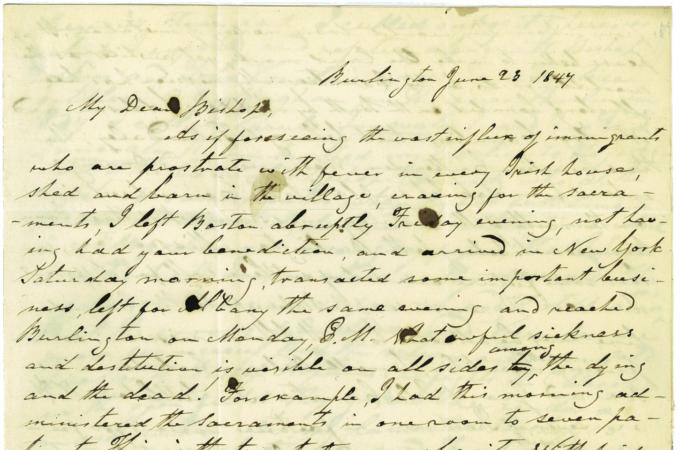Vermont's first resident priest
On June 23, 1847, Father Jeremiah O'Callaghan wrote Bishop John Bernard Fitzpatrick of Boston, describing a terrible epidemic afflicting his congregation in Burlington, Vermont. The culprit was what he referred to as "ship fever," a form of typhus carried by lice, which would have infected the recently arrived Irish immigrants during their long voyage across the sea. In his letter, Father O'Callaghan describes how the victims were "prostrate with fever in every Irish house, shed and barn in the village, craving for the sacraments....What awful sickness and destitution is visible on all sides among the dying and the dead."
Father O'Callaghan was a native Irishman himself, having been born in County Kerry, Ireland, about 1780. He was ordained in the Diocese of Cloyne in 1805 by Bishop William Coppinger, but the young priest expressed extreme views towards certain financial institutions and practices, believing they encouraged avarice, among other sins. These views, or the way in which he chose to express them, led him into a disagreement with his bishop, and his subsequent departure from the diocese.
For the next 11 years, Father O'Callaghan travelled throughout the world, including his home country of Ireland, Rome, England, Canada, and finally the United States. It was in the latter he met Bishop Benedict Joseph Fenwick of Boston, who, looking beyond Father O'Callaghan's former indiscretions, saw potential in the priest. Bishop Fenwick's judgement proved sound, as Father O'Callaghan would later be described as "one of its (New England's) most effective missionary priests of the next thirty years."
Heeding appeals from both Father James Fitton and Catholic laymen in Vermont, Bishop Fenwick dispatched Father O'Callaghan to the region. He departed Boston on July 6, 1830, and spent the first two months of his assignment touring the state, the entire Catholic population of which was now his responsibility.
At the conclusion of his tour the signs of a growing Catholic community began to appear, including the communities of Vergennes, St. Albans, and Swanton expressing their intentions to build churches. Similarly, upon his arrival in Burlington, a prominent citizen donated five acres of land to Father O'Callaghan for the same purpose.
According to the History of the Archdiocese of Boston, though Father O'Callaghan was "quick-tempered," and "lacking in tact and polish...he more than made up for such defects by his extraordinary energy and activity, his wisdom and foresight...and his love and devotion to his task." Already responsible for the entire state of Vermont, he ventured into both Northern New York and Western Massachusetts as needed by the people there. He built the first church in Burlington on the donated land, which Bishop Fenwick dedicated to St. Mary on September 9, 1832.
Though there were positive signs of growth, others saw the influx of Irish Catholic immigrants as a threat, a nationwide phenomenon. A group of "natives," calling themselves the Native American Association, successfully burned St. Mary's to the ground, and wished to ride Father O'Callaghan on a rail out of town had he not been away at the time. No charges were brought forth after an investigation and, fortunately, the Nativist movement was short-lived.
Undiscouraged, Father O'Callaghan continued to serve the estimated 5,000 Vermont Catholics in the early 1840s, and constructed a new church to replace St. Mary's. Bishop Fenwick was once again present to dedicate the new structure to St. Peter on Oct. 31, 1841.
By the 1847 epidemic, the community appears to have largely healed. He writes in his letter to Bishop Fitzpatrick that "with pride and pleasure I bear testimony to the noble humanity of the natives. They have taken every precaution consistent with the shortness of the notice given them, and with great numbers in need, to make the necessary provisions." He also mentions the "Poor-Master" and town physicians were "on the alert, making the rounds to console and relieve."
He closes this section of his letter with the hope that "the town meet both here and hereafter with the heavenly reward of their prompt philanthropy." And that there will be a speedy end "to the terrific sufferings of the sons of St. Patrick."
For Further Reading:
"An Inland See: A Brief History of the Roman Catholic Diocese of Burlington" by Howard Coffin (2001).
"History of the Archdiocese of Boston", by Robert H. Lord, John E. Sexton, and Edward T. Harrington (1945).
"Usury, funds, and banks..." by Father Jeremiah O'Callaghan (1834). Available via archive.org.



















